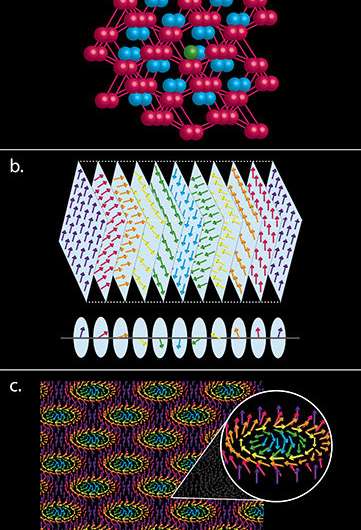Chemical 'pressure' tuning magnetic properties

Unusual, tiny vortexes spinning on the surface of certain magnets could offer a way to reduce the energy demands of computers. Controlling the vortexes is key. Scientists found that chemical substitution in a well-studied magnet acted as an effective knob in tuning the magnetic properties. Adding just a few slightly larger atoms to the magnet expanded the crystal lattice, or atomic arrangement. The expansion applied a "negative chemical" pressure on the system. The pressure changed the character of the magnetism and stabilized an exotic vortex phase called the skyrmion lattice.
This furthered understanding of how to create and stabilize skyrmions could bring us closer to magnetic memory devices that require less electrical current to be controlled. The work also provided insight into the origin of interactions responsible for skyrmion formation.
Since the discovery of magnetic skyrmions—topologically stable vortex-like spin texture—in a well-studied magnetic metal in 2009, much research is focused on the fundamental properties and origin of this unusual magnetic phase. Skyrmions are relatively large and sensitive to low currents and therefore have the potential for low-power electronic devices.
The present work focused on understanding the features that create and stabilize skyrmions, particularly an anti-symmetric interaction believed to be responsible for the development of the skyrmion lattice. Scientists used chemical substitution with slightly larger atoms at non-magnetic sites on the crystal lattice to expand the structure. Unexpectedly at relatively low levels, chemical substitution affected the magnetic character and charge transport properties.
Experiments revealed a change in the character of the electronic structure thought to be the determining factor for the anti-symmetric interaction at the heart of skrymion formation. This research showed the dramatic dependence of the magnetic state on the size of the crystal lattice and points out the opportunity for exploring the origins of anti-symmetric interactions through a combination of experiment, neutron scattering, and electronic structure calculation.
More information: C. Dhital et al. Effect of negative chemical pressure on the prototypical itinerant magnet MnSi, Physical Review B (2017). DOI: 10.1103/PhysRevB.95.024407
Journal information: Physical Review B
Provided by US Department of Energy



















